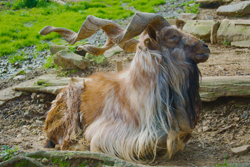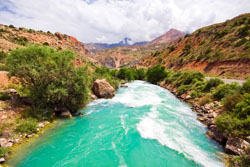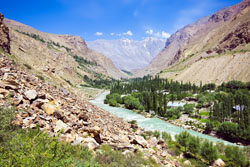Central Asia Traveling in Tajikistan
No tour to Central Asia is complete without a visit to Tajikistan. This country is located in the middle of Central Asia, with India to the south and China to the east. With three arterial routes running through its territory, this province became a notable connective juncture of the Great Silk Road, which is an essential historic site of any tour to Central Asia. The three primary connective branches of the Silk Road which went through Tajikistan were the Sogdian, the Karategin and the Pamir Road. Sogdian, the northern road, connected China with Samarkand in Uzbekistan. The Karategin road joined China with Termez, Uzbekistan, while Pamir Road linked China with Afghanistan. These branches of the Silk Road had a powerful impact on the history and development of Tajikistan, as evidenced by the monuments, museums and the culture of the people in this portion of the tour to Central Asia.
Tajikistan Mountains
Like many other countries in Central Asia, Tajikistan is a land of exhilarating natural contrasts. The Pamir Mountain range, a main attraction on the tour to Central Asia, is the highest mountain range in Central Asia, and it occupies approximately one half of the country’s territory. With snow- topped peaks rising higher than seven thousand meters above sea level, the Pamir Mountain Range is often referred to as “The roof of the world”. One of the mountain peaks, called Ismoil Someni, reaches a height of seven thousand four hundred ninety-five meters! Among the massive mountain ranges there are many high peaks and frozen glaciers. The largest glacier in Central Asia, the Fedchenko, is located here among the mountains of Tajikistan.
On the other hand, there are also low valleys in Tajikistan that have mild, sub-tropical climates. This is a good example of the sort of natural contrasts that exist in Tajikistan as well as in several other countries on the tour of Central Asia.
Besides being known as a country of mountains, Tajikistan is also known for its many hundreds of sparkling blue lakes. There are approximately thirteen hundred beautiful lakes scattered throughout this region of Central Asia. Lake Karakul, a highlight on the tour of Central Asia, holds the honor of being the highest salt-water lake in all of Central Asia. Another famous lake in Tajikistan is the Iskanderkul Lake, situated high in the Fann Mountains. This lake is of glacier origin, and according to legend is believed to be named after Alexander the Great. The name “Alexander” is pronounced “Iskander” in Central Asia, and the word “kul” means “lake” in the Tajik language. Considered one of the most gorgeous mountain lakes in the entire region of the former Soviet Union, Iskanderkul Lake is a very popular site of any tour of Central Asia.
While not actually a highlight of your tour of Central Asia, the following is an interesting event which took place in the mountains of Tajikistan in 1999: The event was known as the International Climbing Expedition, and it was orchestrated as a dedication to honor the eleven hundredth anniversary of Saminid. There were more than seventy-five mountain climbers who came from over thirteen countries in order to participate in this thrilling climbing expedition.
Dushanbe
Dushanbe is the capital city of Tajikistan and the largest city in the country. It is also the administrative and financial center of the nation. The name “Dushanbe” means “Monday” in the Tajik language. It was given this name to reflect the fact that the city grew on the site of a village that was originally a popular Monday marketplace.
Khujand
Considered the capital of northern Tajikistan, this is the second largest city in the country. Dating back to at least the seventh century, Khujand is a very ancient city. Standing at the entrance to the fertile Fergana Valley, Khujand became a vital stop for travelers on the Silk Road, and as a result the city prospered and grew. In time it developed into a prominent cultural center, which now makes it an interesting feature of the tour of Central Asia.
After the Russian invasion in the nineteenth century, Kujand became a center of rapid industrial development. A railway was built, and the city has about twenty large enterprises, universities and cultural establishments. Near the city is a well-known man-made lake, Kairakum, which boasts lovely picturesque scenery and a pleasantly mild climate. The clear water of the lake is excellent for fishing, boating and swimming, and serves as an added attraction for tourists on a tour of Central Asia.
Khujand also has many ancient monuments, citadels, mosques and mausoleums, as well as museums which tell the history of the country. This makes for a fascinating sightseeing experience for travelers who take a tour of Central Asia.


